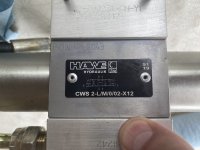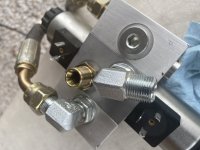Good questions. I don't know about the temp sensor. The way I discovered it was just because I was checking everything over well and getting familiar with the new tractor. I was feeling what I felt like was a lot of heat off the rear end and that area so I grabbed my thermometer and started checking things out.
As far as the factory fill fluid, I don't know what they used. After I had seen 210 one day and 220 the next after mowing only one hour each session I started digging to get to the bottom of this. I was worried about the fluid that was in there and I already had 15 gallons of Kubota SUDT2 so I ordered filters and changed it. FWIW there weren't any metal chunks or anything else that concerned me on the magnet that goes in the suction filter so I'm hoping I caught this before I fried anything. I have 18.5 hours on the tractor now so I'm optimistic I did.
After taking the factory third function out of the circuit and connecting the line that goes back to the rear remote / three point back to the loader valve power beyond with it's original elbow fitting I mowed in the exact same field, same ambient heat conditions for approximately the same amount of time as the other two sessions and recorded 169 degrees. A 40 to 50 degree swing.


